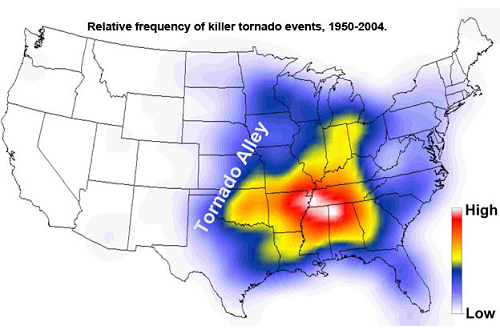Dixie Alley and Tornado Research
This blog is partially a response to Bill’s blog about “Dixie Alley”; scroll down to see this very interesting article. It’s not just long-track EF3-EF5 tornadoes that occur in the Southeast at the same frequency as the Plains, it’s all tornadoes. Take a look at the two charts below. The first shows relative freqeuncy of killer tornadoes, and the second (a smaller sample for sure) shows the number of tornado watches issued per county in the US.

Walker Ashley, Northern Illinois University
It is my opinion that the traditional alley, from Texas to Iowa, was developed over the early years of modern tornado research (1950-1980). The perception that the largest number of tornadoes occurred in the Plains came about for several reasons: 1) since it is flat and there are less trees there, tornadoes can be seen from much greater distances, so a higher percentage of the tornadoes that occurred were reported. 2) More of the tornadoes in the Southeast occur at night, when no one can see them anyway. 3) The focus of storm chasing and research has been centered around Norman, Oklahoma since NSSL was built there.
Recently, as the spotter network has become much larger in the Southeast US, and with Doppler radar showing NWS places of likely tornado touchdowns, they have become much more aggressive in assessing damage in remote areas and confirming tornadoes there. These tornadoes have been happening all along, it’s just that we didn’t know about them because no one saw them, or no examined the damage because it was in an unpopulated area. The fact that most people carry a digital camera around in their phone, and there are TV-station cameras on towers all over the SE, help.
This highlights the importance of tornado research in the Southeastern US. Over the past 30 years, almost all tornado research has been in the Plains states, with multi-million dollar projects like “VORTEX”, etc. This research has been very helpful for everyone, as the people at NSSL, NCAR, and universities out there have leanred much about the basic processes of supercells and tornadoes. However, many tornadoes in the Plains (Texas, Oklahoma, Kansas, Nebraska) come from classic supercell storms that are fairly easy for a forecaster to see on radar and issue a warning. Many tornadoes here occur the same way. However, we also have many tornadoes that occur within squall lines, or in non-supercell thunderstorms, even during hurricanes. We also have gravity waves, topography, gradients in friction along the coast, and other effects that can change tornado environments in the SE. These issues make warning for tornadoes here much more difficult.
Given the enhanced difficulty of warning for tornadoes in the Southeast vs. The Plains, the NWS does a great job. We have higher false alarm rates than they do, but that is partially because we occasionally have tornadoes pop out of weak-looking storms on radar, and the NWS woukd rather over-warn than under-warn.
We at UAH, along with other universities like South Alabama, Gerogia Tech, and Florida State, are trying to understand the more complex processes involved in Southeastern tornadoes, to help the NWS offices here to better assess the tornado potential of storms, relative to environmental factors such as mountains, rivers, bays, and waves, and in squall lines, etc., all mainly a problem only in the SE.
We have already learned a lot about these processes, but we are just scratching the surface. All this with much smaller amounts of money than the millions that go to dozens of radars, profilers, and vehicles for the hyped VORTEX 2 (seen on The Weather Channel, etc.), paid by your tax dollars.
In a later blog, I will show you in more depth how terrain, friction, and gravity waves affect tornadoes in Alabama and the Southeastern United States.
Category: Met 101/Weather History




















Comments (5)
Trackback URL | Comments RSS Feed
Sites That Link to this Post